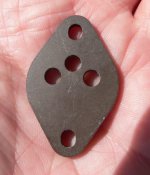But now I'm doing it.
One of the keys to handling high power is handling the thermal challenges with it. China controllers use silicon pads or polyimide (kapton) tape to insulate the mosfets from the heatsink. I've found the perfect insulator - aluminium oxide. By growing a oxide layer 30-50 nm thick it safely insulates against 100-200V. The trick is growing this, you need battery acid, high amperage and refrigerator temperature - without the moisture. I've not been able to score any contract with a chinese company for manufacturing of these in small quantities - so I've settled for making my own little production facillity. I used these chemicals with expencive equipment at school, so if anyone have any tips as to how I can do this safely at home - I'm all ears
Other users of this board has electically connected the mosfets to the heatsink, well good job - you've now got yourself a RF antenna for the noise to efficietly escape the controller.
This is, by far, the best method for connecting mosfets to a heatsink.
One of the keys to handling high power is handling the thermal challenges with it. China controllers use silicon pads or polyimide (kapton) tape to insulate the mosfets from the heatsink. I've found the perfect insulator - aluminium oxide. By growing a oxide layer 30-50 nm thick it safely insulates against 100-200V. The trick is growing this, you need battery acid, high amperage and refrigerator temperature - without the moisture. I've not been able to score any contract with a chinese company for manufacturing of these in small quantities - so I've settled for making my own little production facillity. I used these chemicals with expencive equipment at school, so if anyone have any tips as to how I can do this safely at home - I'm all ears
Other users of this board has electically connected the mosfets to the heatsink, well good job - you've now got yourself a RF antenna for the noise to efficietly escape the controller.
This is, by far, the best method for connecting mosfets to a heatsink.


